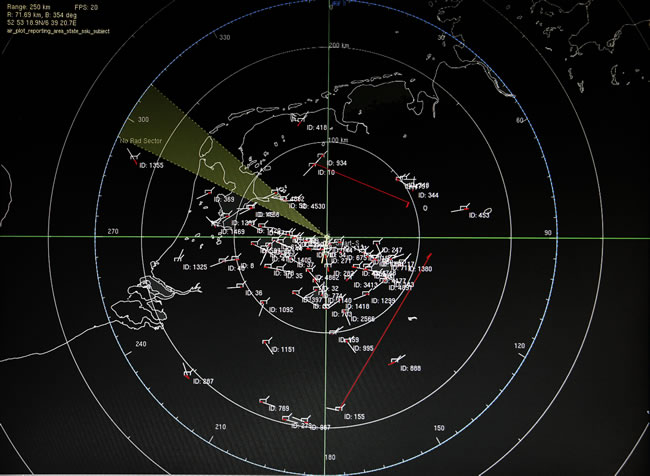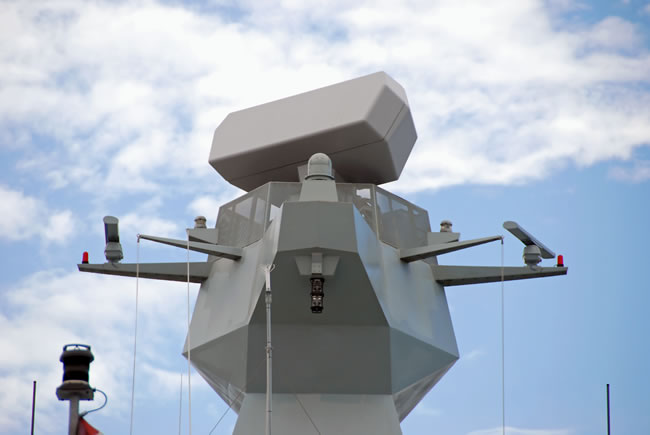

Joint US and European testing of command, control, communications and radar systems are underway to demonstrate the feasibility of integration of European radars and command and control systems into a future missile defense systems based on the planned European Phased Adaptive Approach (EPAA) utilizing the several AEGIS destroyers or cruisers to be based in Spain, land-based SM-3 interceptors to be stationed in Romania and Poland, along with SPY-2 radars sites. These assets are to be complemented by a number of European deployed radar sites.
In recent weeks tests were carried out to evaluate such integration. Last week Raytheon reported about a recent trial that showed that a radar used by Dutch, German and Danish navies could provide target information to the interceptor. The current radar installed on the Dutch frigates is incompatible with the AEGIS/SM-3 link operating over S-band. The demonstration which took place at the Den Helder military test range validated a datalink that allows the missile to receive information from the Thales sensor while retaining the ability to communicate with Aegis combat ships used by the U.S. Navy. Generally, The Dutch, German and Danish navies datalinks are operating on X bands, while Norway, Spain and the U.S. operate AEGIS frigates communicating with their interceptors over the S band. To avoid unique configurations of missiles, Raytheon has developed a dual-band datalink which enables the same missile to communicate in both bands. This dual-band datalink was first tested in 2011.
In 2009, a joint U.S.-Netherlands study concluded SM-3 could be integrated with the Signaal Multibeam Acquisition Radar for Tracking-L (SMART-L) and Advanced Phased Array Radar (APAR) sensor suites, providing non-AEGIS ships a viable missile defense capability. 20 such radars (or their derivatives) are already deployed with frigates and destroyers of six NATO navies, including four DutchDe Zeven Provinciën class frigates, three German Sacsen frigates and three Danish Navy Iver Huitfeldt class frigates.
Six British Type 45 destroyers and four Horizon class frigates of the French and Italian navies are also employing similar radar technology from Thales. To further tighten such integration, the Royal Navy is planning to deploy one of its Type-45 destroyers to take part in a missile interception test to be conducted under the US Missile Defense Agency plan. Another recent test demonstrated datalink connectivity between a French-Italian SAMP/T missile defense unit and the NATO Ballistic Missile Defense Operations Center (BMDOC), using NATO standard Link 16 datalink.
On the recent test, Raytheon’s company-funded the development of the dual-band datalink which would play a key role in enabling more European ships to employ the full range of missiles within the Standard Missile family, including the Standard Missile-3. “Right now, few of Europe’s naval ships can participate in the ‘upper tier’ ballistic missile defense of NATO countries because their radars cannot communicate with the SM-3,” Wes Kremer, vice president of Air and Missile Defense Systems for Raytheon Missile Systems explained. “A common datalink that operates with both X- and S-band radars is a very affordable, near-term solution that allows Europe to take advantage of proven technologies available today.”
Using both sending and receiving signals, the test validated the ability of the dual-band datalink to communicate with the APAR X-band radar, which is part of a radar suite used by the Danish, Dutch and German navies. Integrating a dual-band datalink into any of the Standard Missiles is a ‘drop in’ replacement for the current hardware. “The dual-band datalink has significant implications for our U.S. Navy customers as well, because it allows them to save money by eliminating the need to maintain two separate inventories of Standard Missiles for the Zumwalt (X-band) and Aegis (S-band) ship classes,” said Kremer.

















